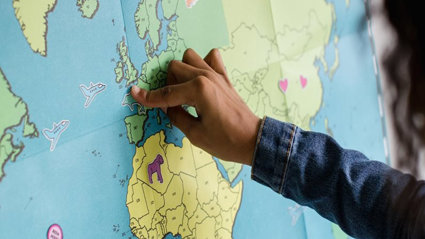
Assessment and progression
This section provides advice and support about planning for assessment and progression at both class and whole school levels
This section of ‘Developing Primary Geography’ is aimed at individual class teachers as well as subject leaders and provides advice and support about planning for assessment and progression at both class and whole school levels. There are useful supporting documents to download, including an assessment framework.
How do I assess geography?
Assessment in geography should:
- Help pupils make progress.
- Help you give better feedback to pupils.
- Identify weaknesses and areas for development.
- Identify more able pupils and those who are struggling.
- Reveal the effectiveness of teaching and learning strategies.
- Identify and compare progress within and between classes, year groups and other schools.
- Help you report to parents.
- Identify how well pupils enjoy the subject.
Since the removal of Level Descriptors in geography, teachers and schools are free to use their own assessment methods in geography at Key Stages 1-3. There are however, statutory Performance - P Scale - attainment targets for pupils with special educational needs who are unable to access the National Curriculum in Key Stages 1-3.
The National Curriculum in geography at KS1 and 2 states the following:
“Attainment targets: by the end of each key stage, pupils are expected to know, apply and understand the matters, skills and processes specified in the relevant programme of study” (DfE [2013], p.2).
An effective assessment regime should ensure adequate progression and challenge matched to pupils’ needs and the National Curriculum Programmes of Study for geography.
The Geographical Association has produced some helpful advice and a progression document with clear statements about end of Key Stage 1-3 expectations. These statements are useful in allowing you to benchmark progress across and between key stages and other schools. The document also outlines some useful approaches for formative and summative assessment.
Assessment starts with planning. As you start to plan out the National Curriculum Programmes of Study across Key Stage 1 and 2, use the end of Key Stage expectations from the Geographical Association to help identify some assessment stepping stones that will challenge children appropriately in different year groups.
The ‘Planning and Assessment at KS1’ document (available below) uses the requirements of the Programmes of Study in geography for KS1 and the benchmarking statements from the Geographical Association for the end of KS1 to create a series of suggested ‘I can’ statements that can be used to support teaching and assessment. You could adapt this approach to suit your school and personalised curriculum.
Please be aware that we do not currently have the same document covering KS2. You might like to have a look on the Geographical Association's website for this.
What records of assessment are useful?
Formative assessment is the everyday use of feedback and intervention to support pupils’ progress. Annotated work and geographically- focused marking feedback work well in providing feedback and capturing evidence. The download ‘Assessing Primary Geography’ gives a flavour of this.
Book scrutiny is a useful source of evidence but much of geography, especially in the early years, may be practical. Here, photographic evidence with a brief explanation provides a useful way to record activities and outcomes. Notes scribbled on planning documents recording tweaked outcomes also provide useful evidence of progression and can help inform ‘next steps’.
Context slips are a helpful way to support both photographic evidence and pupils’ written work. These are small slips which give the date, context of work and support given to individual pupils or groups. Keep a portfolio of work from your class either in hard copy or electronic form and use examples from lower, middle and higher ability children.
Summative assessment is a more quantifiable method of assessment that provides a snapshot of attainment. This is helpful at the end of a year or key stage in order to gauge progress within, across and between classes over time.
How to choose to record and present this is up to you but ideally it should identify those pupils who are coping with the provided planning, and working at expected levels of attainment; those who are struggling and those who require more challenge.
It should also ideally identify strengths and weaknesses in particular aspects of the curriculum. Any summative assessment framework should be able to be easily viewed and understood.
How do I assess geographical skills like mapping?
The Ordnance Survey (OS) has a school mapping subscription service Digimap for Schools which has a number of planning and assessment documents available to freely download from their site.
One of these is a Progression in Mapping Document for Key Stages 1-2 which details a suggested sequence of skill acquisition. This document is helpful for adding appropriate detail to curriculum planning for geography in year groups 1-6.
The Primary Geography Quality Mark
The Primary Geography Quality Mark (PGQM), offered by the Geographical Association, is a self- assessment tool that allows schools to track, evidence and seek accreditation for the quality of geography in their school. The PGQM uses the Ofsted (2015) Inspection headings and criteria drawn from the last Ofsted geography-subject-focused guidance for inspectors.
Useful resources
File nameFiles
File type
Size
Download
